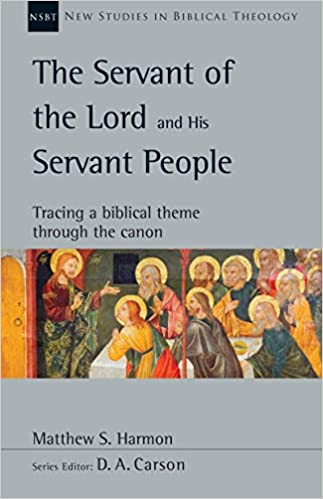An Author Interview from Books At a Glance
Greetings! I’m Fred Zaspel, and welcome to another Author Interview here at Books At a Glance.
Today we are talking to Dr. Matthew Harmon about his new installment in IVP’s New Studies in Biblical Theology series, entitled, The Servant of the Lord and His Servant People.
Matt, great to have you with us, and congratulations on a unique book.
Harmon:
Thank you! It is good to be with you.
Zaspel:
Isaiah’s prophecy is of course famous for its “Servant of the Lord” passages, but just what is your book all about? I do not think I have seen this topic explored in this way before.
Harmon:
I am convinced when people hear the expression servant of the Lord, their minds tend to gravitate toward Isaiah and those servant songs. These are four texts in Isaiah that talk about the work of this servant. The New Testament draws on language from that and connects it to the work of Jesus. As I have done some work in this area what I began to discover was that this theme of the servant of the Lord runs from Genesis all the way to Revelation.
There is this pattern where God raises up an individual servant to lead his people. They often fulfill a prophetic, priestly, and royal role. All with the purpose of producing a servant people who reflect Gods image in their own lives, being servants of the Lord. This book attempts to identify key individual servants of the Lord throughout redemptive history. I begin with Adam and the garden, Moses, Joshua, David, and the Issianic servant of the Lord. I show how they all culminate in the person of Jesus. Even through the work of Jesus, he still is creating a servant people. We as the church today have a servant role within the world that we live in.
Zaspel:
Exegetically how do we establish the connections that hold your book together? And talk to us about the terminology – “servant” and “slave.” What are the proper connotations?
Harmon:
The terminology is something that can be tricky when studying a biblical theme. We struggle with the English equivalents moving from both the Hebrew and Greek into English. The Greek and Hebrew terms can have a range of significance. A word for servants in Hebrew can refer to a slave, a person who has no rights of their own. Or it could refer to an honored person within a royal court who had an esteemed position in service to the king. You have this wide range of usage of the terms even in the Old Testament. On into the New Testament, the language is challenging as well. In our English Bibles, you will see the Greek term doulas translated as slave or servant. In English, those words have a different connotation. It becomes challenging to look at each example of the terminology and figure out what the larger context is telling us about what is being talked about. Is the emphasis on the person’s total surrender to the Lord and being owned by the Lord? Or a description of a person set apart by the Lord to accomplish a specific task?
The larger context can take a little bit of work in the original text. I show some of that in the book to help with that. There are examples where I think you can clearly see that an individual is being portrayed as a servant of the Lord without having that explicit title given. You see that especially in how Genesis describes Adam in the garden. I try to make the case that he is portrayed as a servant of the Lord. Genesis talks about him having a royal role made in God’s image. It is linked to a servant image. There is a priestly role as well that is linked to servant language. You can see it most clearly when it comes to Joshua. Joshua is portrayed as the servant of the Lord who is raised up after Moses, but he is not given that title until the very last chapter of Joshua, where his death is described. The whole book is showing how Joshua is the next servant of the Lord without using that title until you get to the description of his death and the reader will see he is the servant of the Lord.
Zaspel:
Tell us how this theme reaches an Old Testament peak in the famous “Servant of the Lord” passages in Isaiah and then in the New Testament in the Gospels’ presentation of Christ.
Harmon:
In Isaiah, we have those four famous servant songs. The servant theme goes beyond those four chapters in Isaiah. There is a pattern that emerges in Isaiah in the first servant song in chapter 42. It describes what Israel is supposed to be. It is supposed to be this light to the nations, a showcase that people would look at and see God’s power and glory on display. Later in Isaiah 42, God says, “who is as blind as my servant or as deaf as my servant.” It introduces this clear notion, Israel, as God’s servant has failed to live up to their identity. As it unfolds, there is a sense that God will have to do something to address that. In Isaiah 49, we get the introduction of what I and many other scholars argue, is an individual servant who will obey where Israel failed. He will be the means by which not only the Jewish people are redeemed and restored, but also the Gentiles. The news of God’s salvation will go to the ends of the earth.
In Isaiah 50, we see the description of the servant’s obedience in the face of opposition. It culminates into one of the most well-known servant sons, Isaiah 53. It describes the servant suffering for the sins of not just Israel, but Gentiles as well and being vindicated through his self-sacrificial offering. When you look at the specific language of how that servant is described you have elements that pick up the prophetic, priestly, and royal role of the servant. It presents an idealized servant figure, as one coming who will perfectly embody all three of these, in contrast to every servant before who has failed. It sets the trajectory of what we see in the gospel accounts, where they apply the servant language to Jesus. They present him as the one who obeyed where Israel failed, suffered for his people, and was a light to the nations. That section of Isaiah is so important in setting the stage for how we understand the life, ministry, death, and resurrection of Jesus. Part of what you see in that Isaiah section is this notion of the individual servant producing a servant people. That sets the stage of what we see in the New Testament.
Zaspel:
How, then, does all this shape the self-identity first of the apostles and then of the church? This theme has real bearing in the areas of ecclesiology and Christian living, right?
Harmon:
Absolutely. It is easy when you see the themes to stop at Jesus and say he is the ultimate servant. He is the ultimate servant but what we see in the New Testament is that God continues to raise up servants in the apostles. Paul, in particular, makes the most reference to this idea in his letters. It is confirmed in the book of Acts. Paul sees himself as a servant of the Lord, raised up by God to create a servant people in the church, through preaching, his missionary work, his letters, and his whole life. When you look forward to the rest of the New Testament and see the different ways the New Testament describes the life and ministry of the church, what becomes apparent is that we also are described in terms and language borrowed from descriptions of the servants. We have a similar function of both church and in our larger culture of having a prophetic, a priestly, and a royal role to some degree. We are the conduit in which God expresses his glory and by which he announces the good news of what Jesus has done for us.
Zaspel:
Okay once more just briefly, give us a brief sketch-overview, just a snapshot of your book so we can have the big picture in mind.
Harmon:
There is a pervasive pattern in Scripture of God raising up individual key servant leaders through whom he calls to exercise a royal, priestly, and prophetic role. He works through these servants to produce a servant people. That pattern culminates through the person and work of Jesus. Through his life, death, and resurrection he has created us as the church as servant people. We are called to be a light to the nations and live out our servant identity in this fallen world.
Zaspel:
We are talking to Dr. Matthew Harmon about his excellent new book, The Servant of the Lord and His Servant People. It is a book that is long overdue – I do not know another book that tracks this developing theme through the canon like this. Read and enjoy.
Matt, thanks for your faithful work, and thanks for talking to us today.
Harmon:
My pleasure! Thanks for having me.


